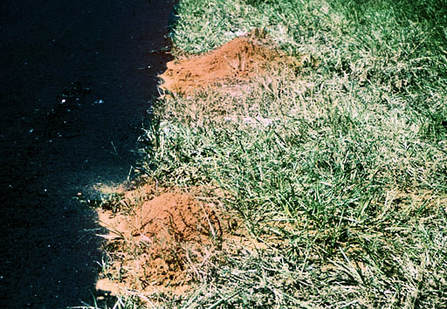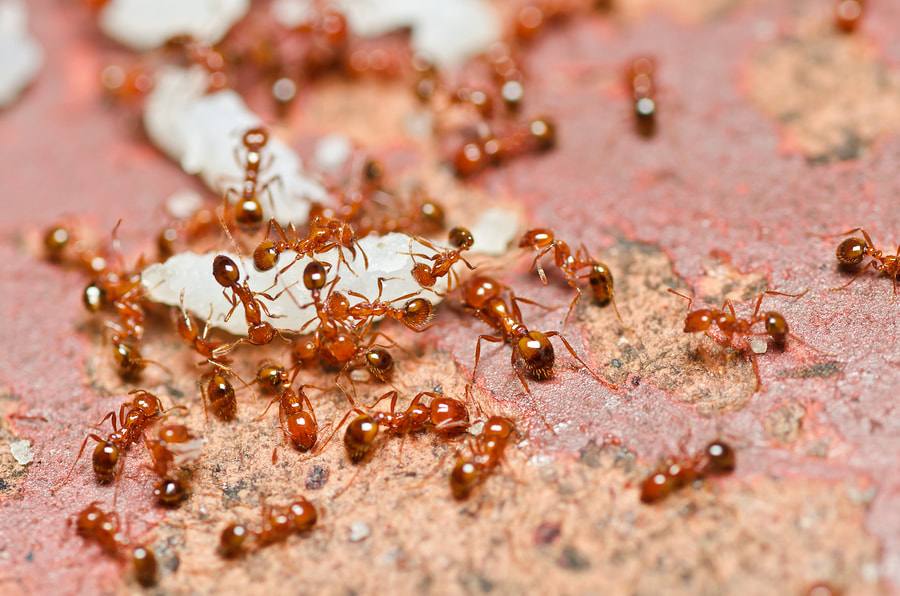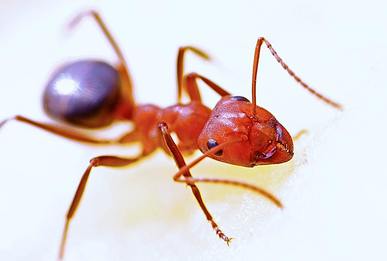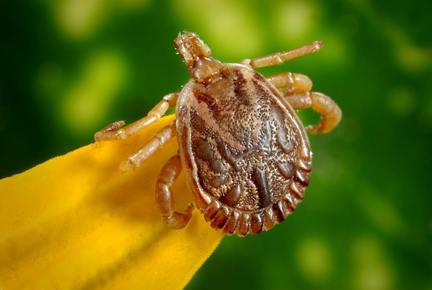Red Imported Fire Ants
Fire ant are omnivorous and can work together to take out birds, lizards, and other small animals. Fire ants don't use their bite to spread their venom. Instead, the bite is used to latch on, and then they sting with a stinger on their abdomen. And boy do they ever sting. Fire ants, when latched on, can use their stinger to attack a victim multiple times. Fire Ants and Your Yard USDA APHIS PPQ - Imported Fire Ant Station , USDA APHIS PPQ, Bugwood.org USDA APHIS PPQ - Imported Fire Ant Station , USDA APHIS PPQ, Bugwood.org The fire ant mound is the tell tell way to visually see that you may have a fire ant colony below. While the mound is the most visible indicator, it isn't necessary for the survival of the colony. Taking it out or disturbing it doesn't take out the colony--more on that in a bit. The ants nest (aka where the queen can be found, and the only thing that can actually destroy the colony) is actually not directly accessible from the mound itself. Unlike other ant hills, access to the the fire ant nest requires a trip along multiple tunnels, and the nest can be SEVERAL feet away from the actual mound visible in your yard. In extreme temperatures (like a nice hot Charleston summer) fire ants can dig even deeper and further away from the mound for protection from the elements. Getting Rid of Those Colonies: Do home remedies work? As far as fire ant treatment goes. It is way easier to work on a preventative plan than it is to eradicate a colony once it has made it's home in your yard. Yards with wide open spaces may want to consider a regular treatment in order to prevent the colony from even starting. However, if those those nasty red mounds start popping up, they can cause fear and panic on how to get rid of them, and many will turn to DIY home remedies and Old Wives' Tales to try and eradicate the problem. However, very few of these methods have success and can even make the condition worse. Let's look at a few of the most popular methods recommended and explain what it is that just doesn't seem to do more than make you dizzy chasing fire ant mounds around your yard. Solution Suggestion #1: Grits MYTH: Here in the South, grits are staple. We like to eat them with everything. There's creamy grits, baked cheese and grits, shrimp and grits, heck--there's even a creamy sweet grits pie! You may even find your neighbor recommending you use uncooked grits on and around a fire ant mounds to take care of your problem. I mean, Hey, it worked for them right? What else are you going to use those instant grits for? Surely you're not going to eat instant grits? Your neighbors insists that the ants are supposed to eat the grits and explode. Problem solved. Sounds good right? Think about this: There's a reason "it worked" for them and you now have fire ants. TRUTH: Fire ants really enjoy the sweetness of corn, and yes, they will "eat" the grits, but these grits aren't killing anything. Adult fire ants aren't capable of eating solid food. They will carry the grits back to the colony where the larvae will convert the solid grits into a liquid for the rest of the colony to consume the food. The grits aren't exploding anywhere. The larvae break the grits down into such small particles, there's no chance for explosion to occur. Fire ants' love of sweet corn is one reason it's used in pesticides--not to explode the ants, but to carry the pesticides to the nest. If you use grits and the mound goes away, you may be asking yourself, "but where did the mound go?" The likelihood is that you damaged passage ways to the nest, so the ants simply picked up and are heading to build a new mound elsewhere. You didn't kill them, you just moved their front door. Solution Suggestion #2: Boiling Water MYTH: Pour some boiling water over the mound. TRUTH: While this method is slightly effective, you've got maybe a 50-60% chance it could work, it is extremely dangerous to you. Researchers have found that this method is only effective if enough water is used. In this case, enough water is over 3 gallons! 3 gallons of boiling water? Not something I would want to handle. Boiling water cools very quickly. Without a heat source to maintain the temperature, the water will not remain boiling by the time it reached the queen. If you don't kill the queen, you don't kill the colony. Boiling water ins't worth the risk. You could burn yourself, kill the surrounding vegetation, and possibly not kill the colony. Also, have you EVER seen how ants behave when they encounter water? Solution Suggestion #3: Fight Fire with FireMYTH: Take fire ants from one colony and add them to another colony. TRUTH: Here's another case where all you're really doing is causing more work for those worker ants and not taking care of the real problem: the queen. The worker ants will most likely fight to death, but the queen will remain. The colony will rebuild. In Texas, we're even seeing cases where the different colonies join together and spread even faster. The Best Way to Combat Fire AntsOne of the most effective methods of fire ant treatment is the use of a professional service. A trained professional has access to the most effect pesticides and is equipped with the best knowledge of application. It's best to stay proactive and maintain a consistent fire ant treatment schedule that treats the yard and mounds. Even after the mound are gone, a yard treatment is still recommended to stay on top of and avoid the development of future colonies. Typically, fire ant treatments occur twice a year, and are most effective when applied in the Spring and the Fall. 843.860.4791 Sources:
https://articles.extension.org/pages/60922/what-do-fire-ants-eat http://articles.extension.org/pages/16027/a-fire-ant-smorgasbord http://www.walterreeves.com/insects-and-animals/fire-ant-control-grits/ https://doyourownpestcontrol.com/pest_control/questions_and_answers/top_10_things_you_should_know_about_fire_ants.html
7 Comments
protected from tick-born diseases. Check out this great information about how to look out for ticks and how to protect yourself here. What now? If you do happen to get a tick on you. It's important not to panic. It's important to stay calm, and get the little bugger off! Before you go reaching for those tweezers, make sure you're aware as to how to best remove and attached tick to better decrease your chance of contracting a disease or get an infection from the attachment site. How to Remove a Tick Step 1. Gather all your necessary supplies:
Step 2. Get a Clear View of the Tick Be sure that you can comfortably see what you are doing and that you have a good view of the tick you are trying to remove. If the tick is in a hard to reach area, be sure to enlist the help of a friend in order to avoid improperly removing the tick. Step 3. Get a Hold of the Tick Take your tweezers--a set of fine-tipped tweezers are highly recommended--and gently grab hold of the tick as close to the skin as possible. Step 4. Remove the tick Lift the tick to a 90 degree angle away from the skin. Use a gentle and even pressure to pull the tick out from it's hold. It is IMPORTANT that you DO NOT twist or yank the tick from your body. Doing so could result in leaving the tick's mouth attached to your body. The tick wants to stay, and its saliva can act as cement of sorts. The tick attaches itself really well, and it makes removal all the more difficult. Patience and a steady hand are key. Step 5. Clean Up You will want to be sure to clean the area thoroughly. Use the alcohol or warm, soapy water to cleanse the area. Step 6. Disposal
You will need to kill the tick by placing it in rubbing alcohol. Then you can flush it down the toilet or wrap it tightly in tape and throw out. You can also choose to have the tick analyzed to see if it carries any diseases. For this you will need to keep the tick alive, and store it in a container for testing. Summertime. South Carolina. Ticks.
Often these activities include hiking, camping, spending time outdoors--but before you plan your last summer excursion, you need to think about what may be hiding and waiting to put an end to any fun you might be planning. Ticks and Disease Ticks are parasites that attack from the outside of the body. These pests require a blood meal in which to survive. This type of contact between a tick and it's host contributes to the spread of disease from the tick to the host. Not all ticks transmit diseases, but taking precautions is key in protecting yourself, your children, and your pets from tick borne diseases like Lyme disease, Ehrlichiosis, Southern Tick-Associated Rash Illness(STARI), and Rocky Mountain Spotted Fever. When diagnosed early, tick borne diseases are very treatable. Diagnosis and early treatment is key. Lyme disease is the most common disease transmitted by ticks reported on an annual basis with an increase of over 80% of reported cases from 2004 to 2016 according to the CDC. Lyme disease is a bacterial disease that affects muscle strength, can cause arthritis, rashes, severe headaches, and possibly inflammation of the brain. While Lyme disease is one of the most common tick-born illnesses, Rocky Mountain Spotted Fever is the most deadly. The Rare but Deadly Rocky Mountain Spotted Fever
Reported cases of the rare but deadly Rocky Mountain Spotted Fever have been increasing over the past several years with one reported death in Wisconsin so far this year. Veterinarian offices are reporting an increase of cases in dogs, and pediatrician offices have treated cases in children as young as 5. Know What to Expect and Where to Expect It
Dogs and other small animals are only 8-12 inches off the ground and like to lay around in grassy areas which makes them a prime and easy target. How You Can Protect Yourself The fear of tick-born illnesses shouldn't deter you from enjoying yourself in these last few weeks of summer. Here are a list of things you can do to stay on the safe side: 2. Daily Tick Checking: It's a great idea to check yourself daily for ticks that might be climbing upwards. If a tick hasn't latched on, removing it before it has a chance to is by far the safest way if preventing the transmission of tick-born diseases. It's important to check those spots that aren't as visible with the naked eye:
4. What you Wear Matters: Wear long-sleeved shirts and long pants. If you wear lighter color clothing, it will make it a lot easier to identify ticks on your clothes.
Take time and enjoy your summer. Be mindful of your surroundings, and always check yourself and your pets. Remember, wash any possibly contaminated clothes before simply throwing them in a hamper. Not all ticks carry diseases but tick removal is important. The longer a tick stays attached, the greater your chances of having a tick-born disease transmitted. If you fear that your yard may be a tick haven, don't hesitate to give us a call at Champion Pest Management. We can come out and assess your yard situation, and discuss a treatment plan that best suits your needs, your family's needs, and your pets' needs. 843.860.4791
[email protected] |
About UsChampion Pest Management is a locally owned, family run, pest control company operating in Charleston, SC and the surrounding areas. Archives
February 2023
Categories
All
|
|















 RSS Feed
RSS Feed


